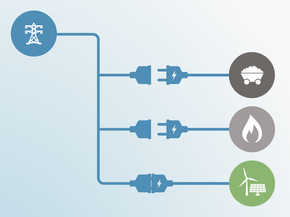Targets
Target Overview
Saudi Arabia submitted an updated NDC on 23 October 2021, increasing the 2030 emissions reduction target from 130 MtCO2e in the first NDC to 278 MtCO2e in the updated one. However, we do not consider this a stronger target, as the median of the NDC range remains lower than Saudi Arabia’s emissions trajectory based on current policies. We interpret the NDC target to be a reduction below a baseline scenario, similarly to the previous one, although this is not explicitly mentioned in the document. It is important to note that neither the previous NDC nor the updated one includes a baseline projection to which the emissions reduction target is applied.
The 2021 NDC, similarly to the previous version, mentions that the reduction target is contingent on international climate action under the Paris Agreement not causing an “abnormal burden” on its economy. The NDC specifically mentions that the emissions reductions are based on a scenario under which hydrocarbons exports continue to provide a ‘robust contribution’ to the Saudi economy.
Under a second scenario, which we understand to be a scenario under which global hydrocarbons exports decline, Saudi Arabia would continue what it calls a ‘sustainable utilisation of hydrocarbons’ domestically. Under this scenario, Saudi Arabia reserves itself the right to revise its NDC.
Saudi Arabia plans to meet part of its emissions reduction targets through the use of a carbon market scheme and Article 6 mechanisms, including for both the 2030 NDC and 2060 net zero targets. However, details on how these mechanisms might be used are lacking or unclear; they present major risks that Saudi Arabia will seek to use carbon credits with questionable integrity as a smokescreen to justify continuing its trajectory of maintaining high levels of domestic emissions.
| SAUDI ARABIA — Main climate targets |
|---|
| 2030 unconditional NDC target | |||
|---|---|---|---|
| Formulation of target in NDC | The Kingdom of Saudi Arabia aims to reduce emissions by 278 MtCO2e annually by 2030, with 2019 as the base year | ||
|
Absolute emissions level in 2030 excl. LULUCF |
520–800 MtCO2e 9% below 2010 / 42% above 2010 levels |
||
| Status | Submitted on 23 October 2021 | ||
| Net zero & other long-term targets | |||
|---|---|---|---|
| Formulation of target | The Kingdom of Saudi Arabia aims to reach net zero greenhouse gas emissions by 2060 | ||
|
Absolute emissions level in 2050 excl. LULUCF |
Not available as net zero target by 2060 only announced as a visionary statement | ||
| Status | Announced in October 2021 | ||
NDC updates
Saudi Arabia submitted its updated NDC on 23 October 2021, increasing the 2030 emissions reduction target from 130 MtCO2e in the first NDC to 278 MtCO2e in the updated one.
The 2021 NDC lists the following mitigation measures:
- Energy efficiency, particularly in the industry, buildings, and transport sectors
- Renewable energy in the power sector, making up 50% of the electricity mix by 2030, and to generate green hydrogen
- A switch from oil to gas in the electricity sector
- Zero flaring in the oil and gas industry
- Carbon capture utilisation and storage (CCUS), coupled with blue hydrogen
As Saudi Arabia has not yet communicated the business as usual (BAU) range for its NDC target, we quantified the target based on a business as usual scenario developed by the King Abdullah Petroleum Studies and Research Center (KAPSARC) (KAPSARC, 2021), a Saudi-based organisation.
The lower end of the BAU range reflects the KAPSARC BAU scenario, excluding land use, land use change and forestry (LULUCF). For the upper end of the range, we have assumed that LULUCF measures would contribute 200 MtCO2e of the total 278 MtCO2e emissions reductions in the NDC. This number is based on the announcements made at the Saudi Green Initiative Forum in 2021. However, in 2012, the latest year for which national data is available, the land use and forestry sink stood at just 9 MtCO2e (UNFCCC, 2020), with forests covering a mere 0.5% of Saudi Arabia’s total land area in 2021 (World Bank, 2023).
Based on this BAU range, and due to the uncertainties around the contributions of emissions reductions from land use and forestry, we project Saudi Arabia’s NDC emissions level to be anywhere between ~520–800 MtCO2e in 2030, excluding LULUCF. This represents an approximate change of –24% to +14% compared to 2021 levels. We do not consider the updated NDC target to be an increase in ambition compared to the previous target, as the median of the NDC range remains lower than Saudi Arabia’s emissions trajectory based on current policies.
| SAUDI ARABIA — History of 2030 NDC updates | First NDC | 2021 NDC update |
|---|---|---|
| 1.5°C compatible |
|
|
| Stronger target | N/A |
|
| Fixed/absolute target |
|
|
| SAUDI ARABIA | First NDC | 2021 NDC update |
|---|---|---|
| Formulation of target in NDC |
Unconditional target: “The actions and plans outlined in this submission seek to achieve mitigation co-benefits ambitions of up to 130 million tons of MtCO2eq avoided by 2030 annually through contributions to economic diversification and adaptation.” |
Unconditional target: “The Kingdom aims at reducing and avoiding GHG emissions by 278 million tons of MtCO2eq annually by 2030, with the year 2019 designated as the base year for this NDC.” |
|
Absolute emissions level excl. LULUCF |
Unconditional target: 680 MtCO2e by 2030 |
Unconditional target: ~520–800 MtCO2e by 2030 |
|
Emissions compared to 2010 excl. LULUCF |
Unconditional target: 17% above 2010 emissions by 2030 |
Unconditional target: 9% below 2010 emissions by 2030 / 42% above 2010 emissions by 2030 |
| CAT rating |
Overall rating*: Critically Insufficient |
NDC target against modelled domestic pathways: Critically insufficient NDC target against fair share: Critically insufficient |
| Sector coverage | Economy-wide | Economy-wide |
| Separate target for LULUCF | No | No |
| Gas coverage | Not specified | Not specified |
| Target type | Reduction below BAU | Reduction below BAU |
* Before September 2021, all CAT ratings were based exclusively on fair share and only assessed a country’s target.
Target development timeline & previous CAT analysis
- 04.11.2021: Updated NDC
CAT rating of targets
The CAT rates Saudi Arabia’s NDC target as “Critically insufficient” when compared to modelled domestic pathways. This rating indicates that Saudi Arabia’s NDC target in 2030 reflects minimal to no action and is not at all consistent with modelled domestic pathways limiting warming to 1.5°C. If all countries were to follow Saudi Arabia’s approach, warming would exceed 4°C.
Saudi Arabia's NDC rating against modelled domestic pathways has deteriorated compared to our previous assessment due to an update in our modelled domestic pathways to the pathways assessed in the AR6. This latest evidence shows that Saudi Arabia requires lower 2030 emissions to be consistent with a 4°C compatible pathway.
As a result, its NDC rating is no longer “Highly insufficient” and falls into the “Critically Insufficient” range. Our newer pathways better capture national circumstances - including the recent plateauing in Saudi Arabia's emissions - and for higher temperature levels show less room for emissions growth than the previous set.
The CAT rates Saudi Arabia’s NDC target against fair share as “Critically insufficient”. This rating indicates that Saudi Arabia’s NDC target reflects minimal to no action and is not at all consistent with its fair share of the global mitigation effort to limit warming to 1.5°C. If all countries were to follow Saudi Arabia’s approach, warming would exceed 4°C.
Further information on how the CAT rates countries (against modelled domestic pathways and fair share) can be found here.
Net zero and other long-term target(s)
We evaluate the target as: Poor.
Saudi Crown Prince Mohammed bin Salman announced Saudi Arabia’s net zero target for 2060 at the first Saudi Green Initiative Forum in October 2021 (Kingdom of Saudi Arabia, 2021d). However, the target has yet to be enshrined in law, or in a policy document.
As of October 2023, Saudi Arabia has not submitted a long-term strategy to the UNFCCC.
Since its initial announcement in 2021, the Saudi government has not provided any further detailed information on scope, target architecture, or transparency. Saudi Arabia has not yet provided a clear emissions reduction pathway to net zero (Kingdom of Saudi Arabia, 2021a). The target’s emission coverage remains unclear with the CAT currently assuming that only CO2 emissions are being covered based on scarce available information.
Saudi Arabia intends to reach its net zero target through the Circular Carbon Economy approach, which relies on the use of CCS. The national oil company Saudi Aramco has committed to reaching net zero operational emissions in 2050. However, most oil and gas emissions come from the combustion of fossil fuels, not their production. Saudi Arabia and Aramco’s net zero targets do not take into account emissions resulting from oil and gas exports. They also do not consider the economic risks associated with a continued reliance on fossil fuels exports in a net zero world (for further details, see the “Oil production” section under “Energy supply” here).
For the full analysis click here.
Further analysis
Latest publications
Stay informed
Subscribe to our newsletter






